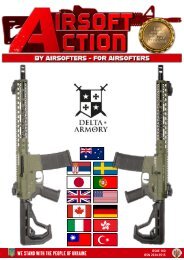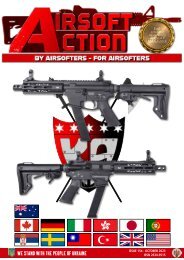PMCI - February 2017
Welcome to a whole new year of Private Military Contractor International. The team hit the ground running with this issue following a very successful visit to SHOT Show 2017 in Las Vegas which is reported fully. This issue also has an in depth interview with Dark Angel Medical and reviews of new knives and tools from SOG, an innovative lighting system for your AR and an overview of a revolutionary new training tool. If you’re working in the private military sector then PMCI is the magazine for you!
Welcome to a whole new year of Private Military Contractor International.
The team hit the ground running with this issue following a very successful visit to SHOT Show 2017 in Las Vegas which is reported fully.
This issue also has an in depth interview with Dark Angel Medical and reviews of new knives and tools from SOG, an innovative lighting system for your AR and an overview of a revolutionary new training tool.
If you’re working in the private military sector then PMCI is the magazine for you!
Create successful ePaper yourself
Turn your PDF publications into a flip-book with our unique Google optimized e-Paper software.
The same happened before WW2 after the experiences of The<br />
Great European War, as WW1 was known and again after each<br />
successive campaign to date.<br />
What was the average weight the soldier was expected to carry<br />
that overloaded him and seriously reduced his combat efficiency?<br />
British, European and American studies from the outset all arrive<br />
at a weight of 55 to 60 lbs. At first glance this may not appear<br />
too great a load, especially when distributed about the soldier’s<br />
body. But it’s the pre-assault loading of extra ammunition (for<br />
personal and support weapons), combat breaching (grenades<br />
and explosives), and defence stores (sandbags, wire and pickets),<br />
the introduction of steel helmets and gas masks, plus all the<br />
other “little items”, today as then, that are deemed useful in<br />
assault but not regularly carried, that push the load up in excess<br />
of 80lbs. Even surpassing 120lbs during periods in WW1 and<br />
2 and in my experience regularly since. No wonder, with that<br />
load, soldiers failed to decisively capture an objective and even<br />
failed to arrive on objective at all, due to physical exhaustion.<br />
Fortunately after the 1890s, the soldier no longer had to carry a<br />
spare pair of trousers and boots into the assault, but greatcoats<br />
were still carried and 15,000 of them were “dumped” by troops<br />
in one WW1 withdrawal: soaking rain adding 20lbs to an already<br />
very heavy coat.<br />
So what is the ideal combat load? I remember reading Captain<br />
Basil Liddell Hart’s memoires about his experiences of the trenches<br />
and his remarking about how the combat load his soldiers had<br />
to endure kept on increasing. He raised the point that a cavalry<br />
horse to perform at optimum should not be loaded beyond a<br />
quarter of its body weight and that pack mules were restricted to<br />
loads of 1/3 body weight; whereas the poor old infantry regularly<br />
staggered through the sucking mud of no-mans-land loaded with<br />
2/3 body weight. Since then, successive studies into what should<br />
be the optimal combat load for an infantryman have arrived at<br />
a figure of 1/3 body weight, on average 35 to 40lbs, in order<br />
to reduce fatigue and maintain a soldier’s battlefield agility,<br />
endurance, and effectiveness.<br />
From my chance encounter with a company of Paratroopers<br />
on a country road in Colchester it would seem that in <strong>2017</strong> we<br />
have still not managed to attain that elusive “magic” combat<br />
load figure. As such, our soldiers are loaded up just as much as<br />
their forebears were 2000 years ago: Taliban heard in radio traffic<br />
referring to patrolling British troops as “tortoises” or “camels” as<br />
they regularly patrolled with loads in excess of 50lbs. Perhaps<br />
though, soldiers of today can take comfort from the fact that a<br />
soldier on the eve of the battle of the Somme in 1916 was loaded<br />
with 80 – 100lbs of equipment, whereas our modern Universal<br />
Soldier equivalent in <strong>2017</strong> carries an 80 – 100lbs burden of<br />
“lightweight” equipment.<br />
References: B H Liddell Hart Memoire, Volume 1 and The<br />
Soldiers Load: Historical Data, Appendix 1 to Annex A, HB (A)/<br />
CM/6/3, Dated 5 January 2004<br />
Our thanks go to Peter Bing MIExpE, Specialist Security and<br />
Operational Support Adviser for kindly letting us reproduce this<br />
article.<br />
SPECIAL REPORT: A SOLDIER’S LOAD<br />
pmcimagazine.com


















